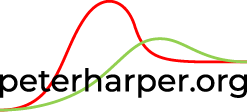Exploring the Structure of the Problem
A metaphorical representation of the gap between political and physical requirements for adequate decarbonisation. On the left are genuine bridges going in the right direction, but (constrained by politics and economics) they don't get very far. The blue rainbow-like shape represents the process of 'back-casting' from a physically realistic future state. It is not a genuine bridge but could show a realistic strategic pathway. As will be obviuous from other material here, I am firmly in the 'physical realism' camp.
The Climate Change problem is at once very simple and very complex. Underlying it all is a basic physical imbalance between energy received and energy emitted by the earth, relative to the interglacial norm of the last 10,000 years. This is largely driven by greenhouse gas emissions (GHGE). The First Law of Thermodynamics tells us that 'things' are bound to happen as a consequence, and climate scientists have worked hard to try and predict at least approximately what things, when.
The complexities arise in trying to graft these basic understandings onto the fabric of modern life. There is enough evidence to suggest that urgent action would be prudent, but enough uncertainty that for the time being pretty well everybody can ignore the incipient problem. By the time it gets bad enough to prompt decisive action, it could well be too late. If this analysis is correct, it is entirely rational to be an 'alarmist', but as we all know, alarmists are ignored and derided for being...alarmist.
The first two items in this section are introductory overviews of the problem, of the kind used in university courses. In many ways they are orthodox, but probably clarify certain issues.
Defining and Measuring Sustainability (ppt)
Sustainability notes 2014 (doc)
Probably the most important conceptual advance in the last five years has been the understanding that cumulative emissions (sometimes referred to as 'carbon budgets') are a key indicator for climate change and appropriate policy. This is a short essay on its implications for the UK.
Implications of Carbon Budgets for the UK 2013 (doc)
The next item uses the 'geometrical algebra' of carbon budgets to examine UK official policy, finds that it falls very short of a genuinely sustainable contribution to the world problem, and calculates a physical value for the shortfall.
What Carbon, where and when? 2014 (doc)
This one (university lecture notes) speculates about alternative futures:
Future Scenarios 2014 (doc)
The other items in this section are several years old and might be considered less relevant to the present situation. However, contemporary understanding is sometimes helped by travelling back in time to see the genesis of certain ideas, and how we were all groping for improved understanding. Things are moving rapidly in this field, so going back five years shows substantial differences, as in these short pieces. The first formally predicts the incipient 'bifurcation of history'; the second attempts to classify different 'schools' and reveals my own views as those of a small minority (but of course I would not hold them if I did not think them correct); the third tries to summarise main features of the debate up to 2009. Occasionally such 'retrospectives' are helpful in gauging the progress of various policy proposals, and the evolution of 'public mood'.
The Most Famous Date in History 2008 (doc)
Cladistics of Views on Climate Change 2008 (doc)
Evolution of the Climate Change Debate 2009 (doc)
Two even older pieces from the pre-climate-change era are still relevant in that on the whole their speculations, based on the ineluctable nature of physical processes, have been borne out. The second of these pieces discusses the strange persistence of pessimistic and optimistic interpretations of the data and attempts to resolve the apparent contradiction. I regard it as an excellent summary of the state of quantitative environmental thinking at the turn of the millennium.
Paradoxes of Sustainability 1995 (doc)
The End in Sight? 2000 (doc)
It is notable that 15, 20 years later we still cannot get the extreme gravity of the prospects for the 21st century taken seriously in mainstream policy or popular discourse. This has been labelled 'the Giddens Paradox' by the distinguished social scientist Anthony Giddens. The previous cited paper notes a special case, that even academia and the research community, with all its privileged information, has failed to engage the problem with due concern. Following Giddens' example, I am tempted to call this 'Harper's Paradox'.
I continued to explore the Great Paradox through the algorithmic straight-jacket of the Kaya Identity. Here are two attempts to extend the Identity beyond its original purpose of decomposing the energy system:
